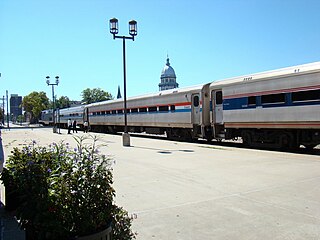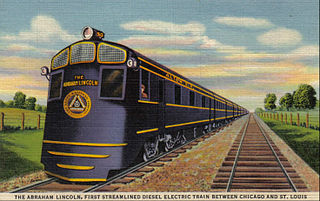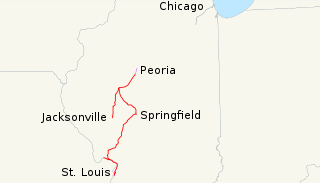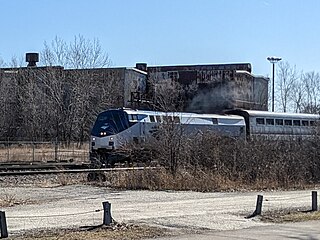
The Chicago and North Western was a Class I railroad in the Midwestern United States. It was also known as the "North Western". The railroad operated more than 5,000 miles (8,000 km) of track at the turn of the 20th century, and over 12,000 miles (19,000 km) of track in seven states before retrenchment in the late 1970s. Until 1972, when the employees purchased the company, it was named the Chicago and North Western Railway.

The Missouri Pacific Railroad, commonly abbreviated as MoPac, was one of the first railroads in the United States west of the Mississippi River. MoPac was a Class I railroad growing from dozens of predecessors and mergers. In 1967, the railroad operated 9,041 miles of road and 13,318 miles of track, not including DK&S, NO&LC, T&P, and its subsidiaries C&EI and Missouri-Illinois.

The Ann Rutledge was a passenger train service operated by Amtrak running between St. Louis, Missouri, and Kansas City, Missouri, as part of the Missouri Services brand. In 2009 Amtrak consolidated the Ann Rutledge, Kansas City Mule, and the St. Louis Mule under the new name Missouri River Runner.

The Lincoln Service is a 284-mile (457 km) higher-speed rail service operated by Amtrak that runs between Chicago, Illinois and St. Louis, Missouri. The train is a part of the Illinois Service and is partially funded by the Illinois Department of Transportation. The train uses the same route as the long-distance Texas Eagle, which continues to San Antonio and Los Angeles. A connection with the Kansas City-bound Missouri River Runner is available in St. Louis.

The Gateway Western Railway was a Class II railroad that operated 408 miles of former Chicago and Alton Railroad track between Kansas City and St. Louis, Missouri. It also operated between Kansas City, Missouri, and Springfield, Illinois on the old Alton Railroad line that eventually was the Chicago, Missouri and Western Railway.

The St. Louis–San Francisco Railway, commonly known as the "Frisco", was a railroad that operated in the Midwest and South Central United States from 1876 to November 21, 1980. At the end of 1970, it operated 4,547 miles (7,318 km) of road on 6,574 miles (10,580 km) of track, not including subsidiaries Quanah, Acme and Pacific Railway and the Alabama, Tennessee and Northern Railroad; that year, it reported 12,795 million ton-miles of revenue freight and no passengers. In 1980 it was purchased by and absorbed into the Burlington Northern Railroad. Despite its name, it never came close to San Francisco.

The Gulf, Mobile and Ohio was a Class I railroad in the central United States whose primary routes extended from Mobile, Alabama, and New Orleans, Louisiana, to St. Louis and Kansas City, Missouri, as well as Chicago, Illinois.

The Chicago, Missouri and Western Railway (CM&W) was a Class II railroad that operated in the midwest of the United States between 1987 and 1989. Never financially stable, less than a year after it was created it was bankrupt and sold off its lines piecemeal to other railroads in 1989.
The Midnight Special was the name of a passenger train formerly operated by the Chicago and Alton Railroad and its successor, the Gulf, Mobile and Ohio Railroad. The train departed Union Station in St. Louis, Missouri, at 11:30 p.m. nightly and arrived at Union Station in Chicago, Illinois, at 7 a.m. the following day. In the heyday of overnight travel, from 1920 through the end of World War II, the Midnight Specials were all Pullman Co. trains carrying no coaches and as many as 12 sleeping cars.

Springfield station is a brick railroad depot in Springfield, Illinois, the state capital. It is at mile 185 on Amtrak's Illinois and Missouri Route. As of 2007, it is served by five daily round trips each way: the daily Texas Eagle, and four daily Lincoln Service frequencies. It will be replaced by the Springfield-Sangamon Transportation Center, which is currently under construction, and expected to open in 2025.

Springfield Union Station in Springfield, Illinois, is a former train station and now part of the complex of buildings that together form the Abraham Lincoln Presidential Library and Museum. It is listed on the National Register of Historic Places, and is located at 500 East Madison Street in downtown Springfield, adjacent to the Lincoln Presidential Library.

The Abraham Lincoln was a named passenger train operated by the Baltimore and Ohio Railroad from 1935 into the 1960s. The Abe Lincoln ran between Chicago and St. Louis on the B&O's subsidiary Alton Railroad. The train later passed to the Gulf, Mobile and Ohio Railroad, and then finally to Amtrak, which retained the name until 1978. Service between Chicago and St. Louis is now known by the umbrella term Lincoln Service. This train was the first streamlined passenger service to travel the 284 miles between Chicago and St. Louis, with Joliet, Bloomington-Normal, Springfield and Alton in between. Passengers can get a glimpse of the Mississippi River between Alton and St. Louis.

The Chicago, Peoria and St. Louis Railroad (CP&StL) was a railroad in the U.S. state of Illinois that operated a main line between Pekin and Madison via Springfield. Its property was sold at foreclosure to several new companies in the 1920s; the portion north of Springfield has since become the Illinois and Midland Railroad, while the remainder has been abandoned, except for a portion near St. Louis that is now owned by the Norfolk Southern Railway.
The following is a brief history of the North American rail system, mainly through major changes to Class I railroads, the largest class by operating revenue.

The Wabash Railroad was a Class I railroad that operated in the mid-central United States. It served a large area, including track in the states of Ohio, Indiana, Illinois, Iowa, Michigan, and Missouri and the province of Ontario. Its primary connections included Chicago, Illinois; Kansas City, Missouri; Detroit, Michigan; Buffalo, New York; St. Louis, Missouri; and Toledo, Ohio.

The Alton Limited was the Chicago & Alton Railway's (C&A) flagship service between Chicago, Illinois. and St. Louis, Missouri. It was introduced in 1899 and re-equipped in 1905 and 1924. The name and service were discontinued in late 1971.

The Dixie Flyer was a premier named passenger train that operated from 1892 to 1965 via the "Dixie Route" from Chicago and St. Louis via Evansville, Nashville, and Atlanta to Florida. However, the train continued until 1969 as an Atlanta to Florida operation, run solely by the Atlantic Coast Line Railroad and its successor, the Seaboard Coast Line. The Flyer's route varied in early years, but by about 1920 was set as follows:

The Joliet Subdivision is a railroad subdivision of the Canadian National Railway in the Chicago metropolitan area. The 33-mile route runs from Joliet, Illinois to Chicago's Bridgeport neighborhood, largely paralleling the route of the Illinois and Michigan Canal. Union Pacific has trackage rights over the route, which meets the Union Pacific Joliet Subdivision at Joliet to reach Bloomington and St. Louis. The line also hosts Metra's Heritage Corridor commuter service, and Amtrak's Lincoln and Texas Eagle service. From Bridgeport, services reach Chicago Union Station via Canadian National's Freeport Subdivision.





















